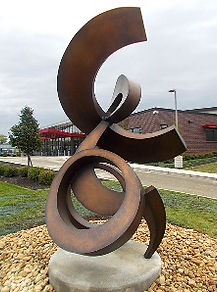
Madison, Wisconsin is a city of stories. High-rise offices, darkened movie theatres and sunny park benches set the scene. Madison’s people, diverse in their histories, become characters in an ever-evolving narrative. Public art plays an intrinsic role. Large-scale, touchable sculpture invites exploration - whether physical interaction (sitting, climbing, leaping) or visual examination.
My interactive work has always attracted families and I hold extensive knowledge of maintenance and liability issues. While design elements such as concept, craftsmanship and execution are clearly vital, practical matters including budget preparation, contracts and insurance are equally important. The proper execution of all facets ensures a project’s complete success.
By incorporating illusionary movement, my sculpture invites contact. Through elements of touch, the viewer (or sitter, climber, leaper) connects with the work on an immediate, visceral level. The sculpture - as playmate and educator - becomes a character of its own, communicating with city and citizen. In unspoken dialogue, the story of Madison continues indefinitely.

A star made of traffic cones resembles a grain of pollen, spiked seedpod, or diatom. Doorknobs resemble a virus or colony of fungi while sunflowers, pineapple, and birds of paradise compose a larger than life garden shovel. The relationship between natural and manmade forms fascinates me. Common everyday objects are created for function yet retain inherent aesthetic, with imagery as poignant as that of the natural world. Synthesizing macro and micro patterns of nature with human-crafted objects incites dual dialogue between the manufactured and the organic. Removing manmade objects from their original context lets us focus on their environmental origins, revealing unexpected beauty.

Most passengers at CTA’s Sedgwick station don’t realize they stand above history. Below the platform, Sedgwick Studio holds a colorful story. Built by Commonwealth Edison, it opened in 1900 as an electrical substation for one of Chicago’s last privately-owned train lines. After removal of transformers converting AC to DC in the early 1960’s, the building sat vacant for over a decade. Luckily, several artists saw high ceilings and specious interior as studios, purchasing the property in 1976. Today Sedgwick Studios is buzzing with energy as a live/work space for five artists with sculpture fabrication, neon shop, and public exhibitions.
Top image, Sedgwick Studio (psst....I also made this website)
Middle image, Safety Star by Victoria Fuller
Bottom image, Chicago Architectural Foundation
